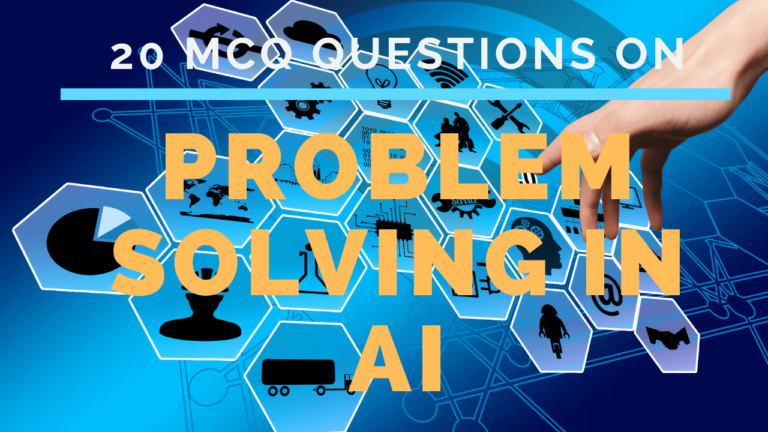Read Also: Solved MCQ on Artificial Intelligence (AI) Set-1
1. State whether the following statements about defining the problem are True or False.
i) A problem will define a state space that contains all the possible configurations of relevant objects.
ii) A problem will specify a set of rules that describe the actions available.
A. i-True, ii-False
B. i-False, ii-True
C. i-True, ii-True
D. i- False, ii-False
2. … provides the frameworks into which more direct methods for solving sub-parts of a problem, can be embedded.
A. Search
B. Problem
C. State
D. State Space
3. A … is a representation of problem elements at a given moment.
A. Search
B. Problem
C. State
D. State Space
4. State whether the following statements about the state space are True.
i) A state-space forms a graph in which the nodes are states and the arch between nodes are actions.
ii) In state space, a path is a sequence of states connected by a sequence of actions.
A. i-only
B. ii-only
C. Both i and ii
D. None of the above
5. A production system consists of
i) A set of rules.
ii) One or more databases.
iii) A Control Strategy
A. i and ii only
B. ii and iii only
C. i and iii only
D. All i, ii and iii
6. … specifies the order in which the rules will be compared to the database.
A. A set of rules
B. A control strategy
C. One or more knowledge
D. A rule applier
7. … is the computational system that implements the control strategy and applies the rules.
A. A set of rules
B. A control strategy
C. One or more knowledge
D. A rule applier
8. Which of the following are the benefits of the production system?
i) Production systems provide an excellent tool for structuring AI programs.
ii) The individual rules can be added, removed, or modified independently.
iii) The production rules are expressed in a natural form.
A. i and ii only
B. ii and iii only
C. i and iii only
D. All i, ii and iii
9. In… the application of a rule never prevents the later application of another rule.
A. monolithic production system
B. commutative production system
C. fully commutative production system
D. bitonic production system
10. … is a production system that is both monotonic and partially commutative.
A. monolithic production system
B. commutative production system
C. fully commutative production system
D. bitonic production system
11. … help us to decide which rule to apply next during the process of searching for a solution to a problem.
A. Control strategies
B. Production system
C. Problem
D. State space
12. State whether the following statements about the uninformed search control strategy are True or False.
i) It does not have additional information about states beyond problem definition.
ii) In an uninformed search control strategy, the total search space is looked for a solution.
iii) Best first search and problem decomposition are examples of uninformed search control strategies.
A. i-True, ii-False, iii-True
B. i-False, ii-True, iii-True
C. i-True, ii-True, iii-False
D. i- False, ii-False, iii-False
13. In… the search generates all nodes a particular level before proceeding to the next level to the tree.
A. depth-first search techniques
B. breadth-first search techniques
C. iterative deepening search techniques
D. heuristic search techniques
14. … does not guarantee to find a solution and backtracking is required if the wrong path is selected.
A. depth-first search techniques
B. breadth-first search techniques
C. iterative deepening search techniques
D. heuristic search techniques
15. State whether the following statements in the heuristic search techniques are True or False.
i) It can be used to limit the search process.
ii) Special-purpose heuristics exploit domain-specific knowledge.
A. i-True, ii-False
B. i-False, ii-True
C. i-True, ii-True
D. i- False, ii-False
16. … search algorithm is a very simple algorithm that guarantees to find a solution if done systematically and there exists a solution.
A. Generate-and-Test
B. Simple Hill Climbing
C. Steepest-Ascent Hill Climbing
D. Simulated Annealing
17. … is often used when a good heuristic function is available for evaluating states but when no useful knowledge is available.
A. Generate-and-Test
B. Simple Hill Climbing
C. Steepest-Ascent Hill Climbing
D. Simulated Annealing
18. … algorithm considers all the moves from the current state and selects the best one as the next state.
A. Generate-and-Test
B. Simple Hill Climbing
C. Steepest-Ascent Hill Climbing
D. Simulated Annealing
19. Simulated annealing differs from … in that a move is selected at random and then decides whether to accept it.
A. Generate-and-Test
B. Hill Climbing
C. Best First Search
D. Simulated Annealing
20. Which of the following are the drawbacks of hill climbing.
i) Local maximum
ii) Plateau
iii) Ridge
A. i and ii only
B. ii and iii only
C. i and iii only
D. All i, ii and iii
Answers:
- C. i-True, ii-True
- A. Search
- C. State
- C. Both i and ii
- D. All i, ii, and iii
- B. A control strategy
- D. A rule applier
- D. All i, ii, and iii
- A. monolithic production system
- B. commutative production system
- A. Control strategies
- C. i-True, ii-True, iii-False
- B. breadth-first search techniques
- A. depth-first search techniques
- C. i-True, ii-True
- A. Generate-and-Test
- B. Simple Hill Climbing
- C. Steepest-Ascent Hill Climbing
- B. Hill Climbing
- D. All i, ii and iii
Read Next: 20 MCQ Questions on Knowledge Representation in AI









